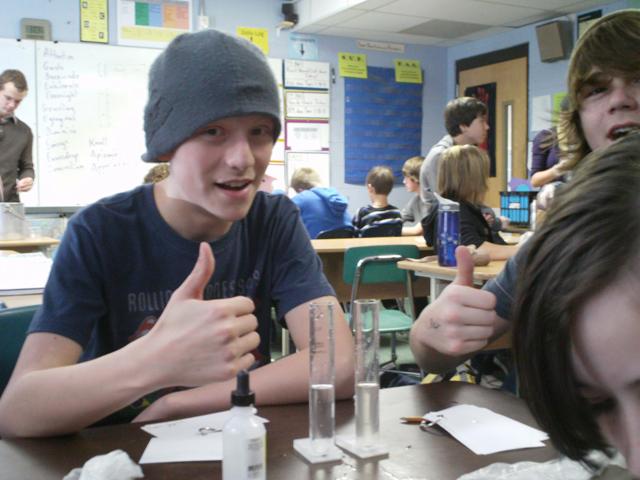Some may remember eighth-grade science as boring and perfunctory, with a focus on things like converting teaspoons to milliliters. Or maybe it was high ick-factor, slicing and dicing your way through some worm’s digestive tract?
But for Stuart Miles’ seventh- and eighth-grade students at Evergreen Community Charter School, science class is more about how they can help save the world — or at least their little corner of it.
Miles, the 2010-11 North Carolina Charter School Teacher of the Year, teamed up with Hayley Smith, RiverLink’s education coordinator, to develop a more hands-on, action-oriented approach to teaching basic environmental science. Over the course of several weeks, students analyzed samples collected in the Haw Creek watershed, drew conclusions from the data and began developing plans for community outreach based on the results.
Water quality is a key component of the state’s standard course of study for public schools. And in years past, Miles has taken his classes to streams throughout Western North Carolina, aiming to make their learning as hands-on and place-based as possible. But even so, he notes, it all felt somewhat artificial, consisting of “get off the bus, test the water, get back on.”
So Miles decided to try something closer to home: assessing the environmental health of the school’s immediate surroundings in the Haw Creek drainage. “This year,” he explains, “They have that ownership of the information they’re gathering.” The 47 eighth-graders also got a taste of the challenges of real-life fieldwork.
“The way our curriculum works out, this field trip would occur in January, where the ink is freezing in their pens and they can hardly hold the bottles. In this case, there were four sites selected in Haw Creek: two on the creek itself (one in the headwaters and one in a more developed area), and two on unnamed streams in the watershed.” Miles collected most of the samples, turning them over to the students along with video showing stream-bank conditions and other aspects of the sites that might suggest potential water-quality impacts.
Students also discussed what constitute “good” and “bad” levels for the five parameters tested (temperature, pH, turbidity, nitrates and phosphates) — pollutants commonly associated with fertilizers and septic systems. And when the data came in, the results were encouraging.
“Haw Creek’s in pretty good shape!” Miles reports. “I encouraged the kids to infer and describe the results as deeply as possible, as in: What is Haw Creek used for? What is our value for our streams and watershed? A lot of what it came down to is that we appreciate the stream for its aesthetics, and we use it as a gauge for the overall health of the watershed and watershed practices in general.”
Students then moved on to the action component, placing “Don’t Pollute — Flows to Waterways” placards provided by RiverLink on storm drains around campus and at the nearby Charlie Bullman Park.
Meanwhile, Miles used the fact that he lives uphill from the school to help drive a fundamental inquiry: Are my choices impacting the stream below?
This, he says, fed students’ growing interest in identifying potential pollution sources. Among their ideas was using high-resolution photos on Google Earth to identify unnaturally green lawns that could help determine future sampling sites.
Miles believes projects like this one provide a “reconnection to our agrarian roots and awareness of the land and its history. We want to do some oral histories with Haw Creek residents, to talk about how this valley has changed from a primarily agricultural valley to the suburban area it is now, to help the students connect to where we are. We’ve tried to bring them into ownership of ‘We are the next generation of Appalachians.’
“As a teacher, you’re always trying to connect them with the ground they’re standing on,” he emphasizes, adding that the school year culminates in a three-day backpacking trip.
“We’ve got a lot of ideas for next year,” adds Miles, noting that students may contact the U.S. Geological Survey to propose a name for one of the unnamed Haw Creek tributaries. Students are also designing fliers describing the project and their desire to maintain local ecological health, for possible mailing to area residents.
“You just have to really be careful,” says Evergreen eighth-grader Noah Hyman. “Fertilizers are good for plants in the ground but can have a harsh impact on animals and plants that live in the streams.” As for the impact of the class, Hyman says, “Having the ability to show people what is happening in our streams is really cool. Stuart makes things really interesting and a lot of fun.”
— Direct your environmental news to Susan Andrew (251-1333, ext. 153, or sandrew@mountainx.com).






I remember 8th grade science as being awesome. Glad that Stuart is continuing the tradition. Thanks, Stuart!
Sean